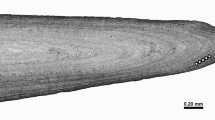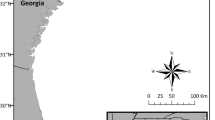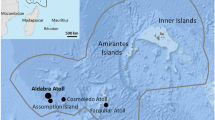Abstract
In response to an absence of size-at-age information for juvenile Chelonia mydas in the South Atlantic Ocean, but the need for such regional data to support global ecological monitoring and conservation actions, skeletochronological analyses (using humeri) were undertaken for 63 stranded dead specimens (30.0–58.0 cm curved carapace length—CCL) collected between 2008 and 2013 from 40 km of beaches off southern Brazil. Specimens were defined as being 2–8 years old and from various nesting sites (based on mitochondrial haplotypes). Parametric mixed-effect models were used to examine variation among CCL, maximum humeral length (MHL) and medial humeral width (MHW) due to age (fitted with a natural cubic smoothing spline), genetic haplotype and various random factors. Genetic haplotype was not significant and subsequently removed from analyses. All three size-at-age parameters had random variability, but changes in somatic C. mydas growth described by MHW were less representative than the others, remaining constant through a linear relationship with age. By contrast, both CCL and the preferred MHL similarly displayed positive exponential-shaped splines, with age-specific growth rates (3- to 7-year-olds) predicted at 1.4–3.4 cm year−1 CCL or 0.2–0.7 cm year−1 MHL. The observed CCL growth was comparable to recent estimates for other global populations, but with southern Brazilian C. mydas generally having larger sizes-at-age. Such intra-population differences can be attributed not only to regional prerecruitment environmental parameters and associated ecological implications (e.g. foraging ecology), but also divergent analytical methods. The choice of the latter to accurately model variable growth rates has implications for comparing size-at-age among other sea-turtle populations.




Similar content being viewed by others
References
Alfaro-Shigueto J, Mangel JC, Seminoff JA, Dutton PH (2010) Where small can have a large impact: structure and characterization of small-scale fisheries in Peru. Fish Res 1:8–17. doi:10.1016/j.fishres.2010.06.004
Arruda WZ, Lentini CAD (2011) Variabilidade da Piscina Quente do Atlântico Tropical. In: Anais XV Simpósio Brasileiro de Sensoriamento Remoto—SBSR/INPE, Curitiba, Paraná, Brasil, pp 7192–7199
Avens L, Goshe LR (2007) Comparative skeletochronological analysis of Kemp’s ridley (Lepidochelys kempii) and loggerhead (Caretta caretta) humeri and scleral ossicles. Mar Biol 152:1309–1317. doi:10.1007/s00227-007-0779-9
Avens LG, Harms LR, Anderson CA et al (2012) Population characteristics, age structure, and growth dynamics of neritic juvenile green turtles in the northeastern Gulf of Mexico. Mar Ecol Prog Ser 458:213–222. doi:10.3354/meps09720
Avens L, Goshe LR, Coggins L, Snover ML, Pajuelo M, Bjorndal KA, Bolten AB (2015) Age and size at maturation-and adult-stage duration for loggerhead sea turtles in the western North Atlantic. Mar Biol 162:1749–1767. doi:10.1007/s00227-015-2705-x
Balazs GH, Chaloupka MY (2004) Spatial and temporal variability in somatic growth of green sea turtles (Chelonia mydas) resident in the Hawaiian Archipelago. Mar Biol 145:1043–1059. doi:10.1007/s00227-004-1387-6
Bjorndal KA, Bolten AB (1988) Growth rates of immature green turtles, Chelonia mydas, on feeding grounds in the southern Bahamas. Copeia 1988:555–564. doi:10.2307/1445373
Bjorndal KA, Bolten AB, Coan AL Jr, Kleiber P (1995) Estimation of green turtle (Chelonia mydas) growth rates from length-frequency analysis. Copeia 1995:71–77. doi:10.2307/1446800
Bjorndal KA, Bolten AB, Chaloupka MY (2000) Green turtle somatic growth model: evidence for density dependence. Ecol Appl 10:(1)269–282
Bolten AB, Bjornal KA, Grumbles JS, Owens DW (1992) Sex ratio and sex-specific growth rates in immature green turtles, Chelonia mydas, in the southern Bahamas. Copeia 1992:1098–1103
Boulon RH, Frazer NB (1990) Growth of wild juvenile Caribbean green turtles, Chelonia mydas. J Herpetol 24:441–445. doi:10.2307/1565071
Brandini FP, Boltovskoy D, Piola A, Kocmur S, Röttgers R, Abreu PC, Lopes RM (2000) Multiannual trends in fronts and distribution of nutrients and chlorophyll in the southwestern Atlantic (30–62 °S). Deep Sea Res I 47:1015–1033. doi:10.1016/S0967-0637(99)00075-8
Butler DG, Cullis BR, Gilmour AR, Gogel BJ (2009) ASRemlR reference manual, release 3. Technical report, Queensland Department of Primary Industries, Australia
Casale P, Heppell SS (2016) How much sea turtle bycatch is too much? A stationary age distribution model for simulating population abundance and potential biological removal in the Mediterranean. Endanger Species Res 29:239–254. doi:10.3354/esr00714
Casale P, Mazaris AD, Freggi D, Basso R, Argano R (2007) Survival probabilities of loggerhead sea turtles (Caretta caretta) estimated from capture-mark-recapture data in the Mediterranean. Sci Mar 71:365–372. doi:10.3989/scimar.2007.71n2365
Castanet J, Smirina E (1990) Introduction to the skeletochronological method in amphibians and reptiles. Ann Sci Nat Zool 11:191–196
Chaloupka MY, Limpus C, Miller J (2004) Green turtle somatic growth dynamics in a spatially disjunct Great Barrier Reef metapopulation. Coral Reefs 23:325–335. doi:10.1007/s00338-004-0387-9
Coelho FV (2015) O que a morfologia craniana pode contribuir no entendimento quanto a evolução e o comportamento das tartarugas-verde (Chelonia mydas) juvenis no sudoeste do oceano Atlântico. Master thesis, Universidade Federal do Paraná, Pontal do Paraná, Brasil
Collazo JA, Boulon R Jr, Tallevast TL (1992) Abundance and growth patterns of Chelonia mydas in Culebra, Puerto Rico. J Herpetol 26:293–300. doi:10.2307/1564884
Colman LP, Patrício ARA, McGowan A, Santos AJB, Marcovaldi MA, Belinni C, Godley BJ (2014) Long-term growth and survival dynamics of green turtles (Chelonia mydas) at an isolated tropical archipelago in Brazil. Mar Biol 162:111–122. doi:10.1007/s00227-014-2585-5
Duarte DLV, Monteiro DS, Jardim RD, Soares JCM, Varela-Jr AS (2011) Determinação sexual e maturação gonadal de fêmeas da tartaruga-verde (Chelonia mydas) e tartaruga-cabeçuda (Caretta caretta) no extremo sul do Brasil. Acta Biol Parana 40:87–103. doi:10.5380/abpr.v40i(1-4).25130
Eguchi T, Seminoff JA, LeRoux RA, Prosperi D, Dutton DL, Dutton PH (2012) Morphology and growth rates of the green sea turtle (Chelonia mydas) in a northern-most temperate foraging ground. Herpetologica 68:76–87. doi:10.1655/HERPETOLOGICA-D-11-00050.1
Flint M, Morton JM, Limpus CJ, Patterson-Kane JC, Murray PJ, Mills PC (2010) Development and application of biochemical and haematological reference intervals to identify unhealthy green sea turtles (Chelonia mydas). Vet J 185:299–304. doi:10.1016/j.tvjl.2009.06.011
Frazer NB, Ladner RC (1986) A growth curve for green sea turtles, Chelonia mydas, in the U.S. Virgin Islands 1913–1914. Copeia 1986:798–802. doi:10.2307/1444963
Gama LR, Domit C, Broadhurst MK, Fuentes MMPB, Millar RB (2016) Green turtle Chelonia mydas foraging ecology at 25 °S in the western Atlantic: evidence to support a feeding model driven by intrinsic and extrinsic variability. Mar Ecol Prog Ser 542:209–219. doi:10.3354/meps11576
González- Carman VG, Falabella V, Maxwell S, Albareda D, Campagna C, Mianzan H (2012) Revisiting the ontogenetic shift paradigm: the case of juvenile green turtles in the SW Atlantic. J Exp Mar Biol Ecol 429:64–72. doi:10.1016/j.jembe.2012.06.007
González-Carman VG, Machain N, Albareda D, Mianzan H, Campagna C (2012) Legal and institutional tools to mitigate marine turtle bycatch: Argentina as a case study. Mar Policy 36:265–1274. doi:10.1016/j.marpol.2012.03.014
Goshe LR, Avens L, Scharf FS, Southwood AL (2010) Estimation of age at maturation and growth of Atlantic green turtles (Chelonia mydas) using skeletochronology. Mar Biol 157:1725–1740. doi:10.1007/s00227-010-1446-0
Goshe LR, Snover ML, Hohn AA, Balazs GH (2016) Validation of back-calculated body lengths and timing of growth mark deposition in Hawaiian green sea turtles. Ecol Evol 6:3208. doi:10.1002/ece3.2108
Green D (1993) Growth rates of wild immature green turtles in the Galápagos Islands, Ecuador. J Herpetol 27:338–341. doi:10.2307/1565159
Green PJ, Silverman BW (1994) Nonparametric regression and generalized linear models, a roughness penalty approach. Chapman and Hall, London
Guebert FM, Barletta M, da Costa MF (2013) Threats to sea turtle populations in the Western Atlantic: poaching and mortality in small-scale fishery gears. J Coast Res 65:42–47. doi:10.2112/SI65-008.1
Guebert-Bartholo FM, Barletta M, Costa MF, Monteiro-Filho ELA (2011) Using gut contents of juvenile green turtles Chelonia mydas to assess foraging patterns in the Paranaguá Estuary, Brazil. Endanger Species Res 13:131–143. doi:10.3354/esr00320
Haimovici M, Rossi-Wongtschowski CLDB, Cergole MC, Madureira LS, Bernardes RA, Ávila-da-Silva AO (2006). Recursos pesqueiros da região sudeste-sul. In: Programa REVIZEE: Avaliação do potencial sustentável de recursos vivos da Zona Econômica Exclusiva: Relatório Executivo, Capítulo 6. Brasília, Ministério do Meio Ambiente. 207–242 (http://www.mma.gov.br/estruturas/revizee/_arquivos/rel_executivo_revizee.pdf)
Haslett J, Haslett SJ (2007) The three basic types of residuals for a linear model. Int Stat Rev 75:1–24. doi:10.1111/j.1751-5823.2006.00001.x
Hirth HF (1997) Synopsis of the biological data on the green turtle Chelonia mydas (Linnaeus 1758). Biological Report 97 (1). August 1997, Fish and Wildlife Service, U.S. Department of the Interior, Washington, D.C
Jardim A, López-Mendilaharsu M, Barros F (2015) Demography and foraging ecology of Chelonia mydas on tropical shallow reefs in Bahia, Brazil. J Mar Biol Assoc UK. doi:10.1017/S0025315415001629
Jordão JC, Bondioli ACV, Guebert FM, Thoisy BD, Toledo LFDA (2015) Green turtle (Chelonia mydas) genetic diversity at Paranaguá Estuarine Complex feeding grounds in Brazil. Genet Mol Biol 3:346–352. doi:10.1590/S1415-475738320140353
Kubis S, Chaloupka MY, Ehrhart L, Bresette M (2009) Growth rates of juvenile green turtles Chelonia mydas from three ecologically distinct foraging habitats along the east central coast of Florida, USA. Mar Ecol Prog Ser 389:257–269. doi:10.3354/meps08206
Lemons G, Lewison RL, Komoroske LM, Gao A, Lai C, Seminoff JA (2011) Trophic ecology of green sea turtles in a highly urbanized bay: insights from stable isotopes and mixing models. J Exp Biol Ecol 405:25–32. doi:10.1016/j.jembe.2011.05.012
Limpus C, Chaloupka MY (1997) Nonparametric regression modelling of green sea turtle growth rates (southern Great Barrier Reef). Mar Ecol Prog Ser 149:23–34
López-Barrera EA, Longo GO, Monteiro-Filho EL (2012) Incidental capture of green turtle (Chelonia mydas) in gillnets of small-scale fisheries in the Paranaguá Bay, Southern Brazil. Ocean Coast Manag 60:11–18. doi:10.1016/j.ocecoaman.2011.12.023
Mansfield KL, Wyneken J, Porter WP, Luo J (2014) First satellite tracks of neonate sea turtles redefine the ‘lost years’ oceanic niche. Proc R Soc B Biol Sci 281:20133039. doi:10.1098/rspb.2013.3039
Matano RP, Palma ED, Piola AR (2010) The influence of the Brazil and Malvinas Currents on the Southwestern Atlantic Shelf circulation. Ocean Sci 4:983–995. doi:10.1098/rspb.2013.3039
McMichael E, Seminoff J, Carthy R (2008) Growth rates of wild green turtles, Chelonia mydas, at a temperate foraging habitat in the northern Gulf of Mexico: assessing short-term effects of cold-stunning on growth. J Nat Hist 42:2793–2807. doi:10.1080/00222930802357335
Mendonça MT (1981) Comparative growth rates of wild immature Chelonia mydas and Caretta caretta in Florida. J Herpetol 15:447–451. doi:10.2307/1563536
Milton S, Lutz PL (2003) Physiological and genetic responses to environmental stress. In: Lutz PL, Musick JA, Wyneken J (eds) The biology of sea turtle, 2nd edn. CRC Press, Boca Raton, pp 163–197
Myers N, Mittermeier RA, Mittermeier CG, Fonseca GA, Kent J (2000) Biodiversity hotspots for conservation priorities. Nature 403:853–858. doi:10.1038/35002501
Naro-Maciel E, Becker JH, Lima EHSM, Marcovaldi MA, DeSalle R (2007) Testing dispersal hypotheses in foraging green sea turtles (Chelonia mydas) of Brazil. J Hered 98:29–39. doi:10.1093/jhered/esl050
Naro-Maciel E, Reid B, Alter SE, Amato G, Bjorndal KA, Bolten AB, Martin M, Nairn CJ, Shamblin B, Pineda-Catalan O (2014) From refugia to rookeries: phylogeography of Atlantic green turtles. J Exp Mar Biol 461:306–316. doi:10.1016/j.jembe.2014.08.020
Patrício R, Diez CE, van Dam RP (2014) Spatial and temporal variability of immature green turtle abundance and somatic growth in Puerto Rico. Endanger Species Res 23:51–62. doi:10.3354/esr00554
Peterson RG, Stramma L (1991) Upper-level circulation in the South Atlantic Ocean. Prog Oceanogr 26:1–73. doi:10.1016/0079-6611(91)90006-8
Petitet R, Secchi ER, Avens L, Kinas PG (2012) Age and growth of loggerhead sea turtle (Caretta caretta) in southern Brazil. Mar Ecol Prog Ser 456:255–268. doi:10.3354/meps09681
Petitet R, Avens L, Castilhos JC, Kinas PG, Bugoni L (2015) Age and growth of olive ridley sea turtles Lepidochelys olivacea in the main Brazilian nesting ground. Mar Ecol Prog Ser 541:205–218. doi:10.3354/meps11532
Piola R, Campos EJ, Möller OO, Charo M, Martinez C (2000) Subtropical shelf front off eastern South America. J Geophys Res Oceans 105:6565–6578. doi:10.1029/1999JC000300
Proietti MC, Lara-Ruiz P, Reisser JW, Pinto LS, Dellagostin AO, Marins LF (2009) Green turtles (Chelonia mydas) foraging at Arvoredo Island in Southern Brazil: genetic characterization and mixed stock analysis through mtDNA control region haplotypes. Genet Mol Biol 32:613–618. doi:10.1590/S1415-47572009000300027
Prosdocimi L, Carman VG, Albareda DA, Remis MI (2012) Genetic composition of green turtle feeding grounds in coastal waters of Argentina based on mitochondrial DNA. J Exp Mar Biol Ecol 412:37–45. doi:10.1016/j.jembe.2011.10.015
Ramirez MD, Avens L, Seminoff JA, Goshe LR, Heppell SS (2015) Patterns of loggerhead turtle ontogenetic shifts revealed through isotopic analysis of annual skeletal growth increments. Ecosphere 6:1–17. doi:10.1890/ES15-00255.1
R Core Team (2015) R: a Language and environment for statistical computing. Vienna, Austria. http://www.R-project.org/
Sales G, Giffoni BB, Barata PC (2008) Incidental catch of sea turtles by the Brazilian pelagic longline fishery. J Mar Biol Assoc UK 88:853–864. doi:10.1017/S0025315408000441
Searle SR (1971) Linear models, vol XXI. Wiley, New York
Selig ER, Turner WR, Tröeng S, Wallace BP, Halpern BS, Kaschner K, Lascelles BG, Carpenter KE, Mittermeier RA (2014) Global priorities for marine biodiversity conservation. PLoS ONE 9(1):e82898. doi:10.1371/journal.pone.0082898
Seminoff JA (2004) Chelonia mydas In: The IUCN Red List of Threatened Species e.T4615A11037468. http://dx.doi.org/10.2305/IUCN.UK.2004.RLTS.T4615A11037468.en. Accessed 20 Sept 2015
Seminoff JA, Resendiz A, Nichols WJ, Jones TT (2002) Growth rates of wild green turtles (Chelonia mydas) at a temperate foraging area in the Gulf of California, Mexico. Copeia 2002:610–617
Seminoff JA, Allen CD, Balazs G et al (2015) Status review of the green turtle (Chelonia mydas) under the US. Endanger Spec Act NOAA Technical Memorandum NOAANMFS-SWFSC, USA, pp 539–571
Snover ML, Hohn AA (2004) Validation and interpretation of annual skeletal marks in loggerhead (Caretta caretta) and Kemp’s ridley (Lepidochelys kempii) sea turtles. Fish Bull 102:682–692
Snover ML, Avens L, Hohn AA (2007) Back-calculating length from skeletal growth marks in loggerhead sea turtles Caretta caretta. Endanger Species Res 3:95–104
Snover ML, Hohn AA, Crowder LB, Macko SA (2010) Combining stable isotopes and skeletal growth marks to detect habitat shifts in juvenile loggerhead sea turtles Caretta caretta. Endanger Species Res 13:25–31. doi:10.3354/esr00311
Snover ML, Hohn AA, Goshe LR, Balazs GH (2011) Validation of annual skeletal marks in green sea turtles Chelonia mydas using tetracycline labeling. Aquatic Biol 12:197–204. doi:10.3354/ab00337
Stram DO, Lee JW (1994) Variance components testing in the longitudinal mixed effects model. Biometrics 50:1171–1177. doi:10.2307/2533455
The IUCN Red List of Threatened Species (2015) www.iucnredlist.org. Accessed 20 Jan 2016
Thompson R (1985) A note on restricted maximum likelihood estimation with an alternative outlier model. J R Stat Soc 47:53–55
van Houtan KS, Hargrove SK, Balazs GH (2014) Modeling sea turtle maturity age from partial life history records. Pac Sci 68:465–477. doi:10.2984/68.4.2
Velez-Rubio GM, Cardona L, López-Mendilaharsu M, Souza GM (2016) Ontogenetic dietary changes of green turtles (Chelonia mydas) in the temperate southwestern Atlantic. Mar Biol 163(3):1–16
Verbyla A, Cullis BR, Kenward MG, Welham SJ (1997) The analysis of designed experiments and longitudinal data by using smoothing splines. Technical report, Department of Statistics, University of Adelaide, Adelaide, Australia
Verbyla AP, Cullis BR, Kenward MG, Welham SJ (1999) The analysis of designed experiments and longitudinal data by using smoothing splines. J R Stat Soc: Ser C (Applied Statistics) 48(3):269–311
Wallace BP, DiMatteo AD, Hurley BJ et al (2010) Regional management units for marine turtles: a novel framework for prioritizing conservation and research across multiple scales. PLoS ONE 5(12):e15465. doi:10.1371/journal.pone.0015465
Wallace BP, Kot CY, DiMatteo AD, Lee T, Crowder LB, Lewison LR (2013) Impacts of fisheries bycatch on marine turtle populations worldwide: toward conservation and research priorities. Ecosphere 4:40. doi:10.1890/ES12-00388.1
Watson DM (2006) Growth rates of sea turtles in Watamu, Kenya. Earth Environ 2:29–53
Welham SJ, Cullis BR, Gogel BJ, Gilmour AR, Thompson R (2004) Prediction in linear mixed models. Aust NZ J Stat 46:325–347. doi:10.1111/j.1467-842X.2004.00334.x
Wyneken J (2001) The anatomy of sea turtles. NOAA Tech Memo NMFS-SEFSC-470, US Dept of Commerce, Miami, Florida, USA
Zug GR, Glor RE (1998) Estimates of age and growth in a population of green sea turtles (Chelonia mydas) from the Indian River lagoon system, Florida: a skeletochronological analysis. Can J Zool 76:1497–1506. doi:10.1139/z98-090
Zug GR, Wynneken AH, Ruckdeschel C (1986) Age determination of loggerhead sea turtles, Caretta caretta, by incremental growth marks in the skeleton. Smithson Contrib Zool 427:1–34
Zug GR, Balazs GH, Wetherall JA, Parker DM, Murakawa SKK (2002) Age and growth of Hawaiian green sea turtles (Chelonia mydas): an analysis based on skeletochronology. Fish Bull 100:117–127
Acknowledgements
We thank Eduardo Secchi and Roberta Petitet for their logistic support and assistance with the skeletochronological analyses. We would also like to express our gratitude to the LEC/UFPR research team for assistance with obtaining the carcasses and to Drs Marco Fabio Correa and Charlie Gray for their helpful comments and assistance. Drs Fernanda Almeida and Laura Prosdocimi are thanked for the genetic analyses. This study was financially supported by the ‘Fundação Grupo O Boticário and Fundação Araucária’ and was performed only with stranded animals; no animal was intentionally captured or killed. In this case, no submission to the institutional ethics committee on the use of animals is required in Brazil. Nevertheless, the project had a research approval by the Ministry of the Environmental—MMA (ICMBio/SISBIO 18955/1–2). Mariane Ferrarini Andrade received a CAPEs grant. The authors had no conflict of interest with the study.
Author information
Authors and Affiliations
Corresponding author
Additional information
Responsible Editor: L. Avens.
Reviewed by Undisclosed experts.
Electronic supplementary material
Below is the link to the electronic supplementary material.
Rights and permissions
About this article
Cite this article
Andrade, M.F., Domit, C., Broadhurst, M.K. et al. Appropriate morphometrics for the first assessment of juvenile green turtle (Chelonia mydas) age and growth in the south-western Atlantic. Mar Biol 163, 254 (2016). https://doi.org/10.1007/s00227-016-3031-7
Received:
Accepted:
Published:
DOI: https://doi.org/10.1007/s00227-016-3031-7




